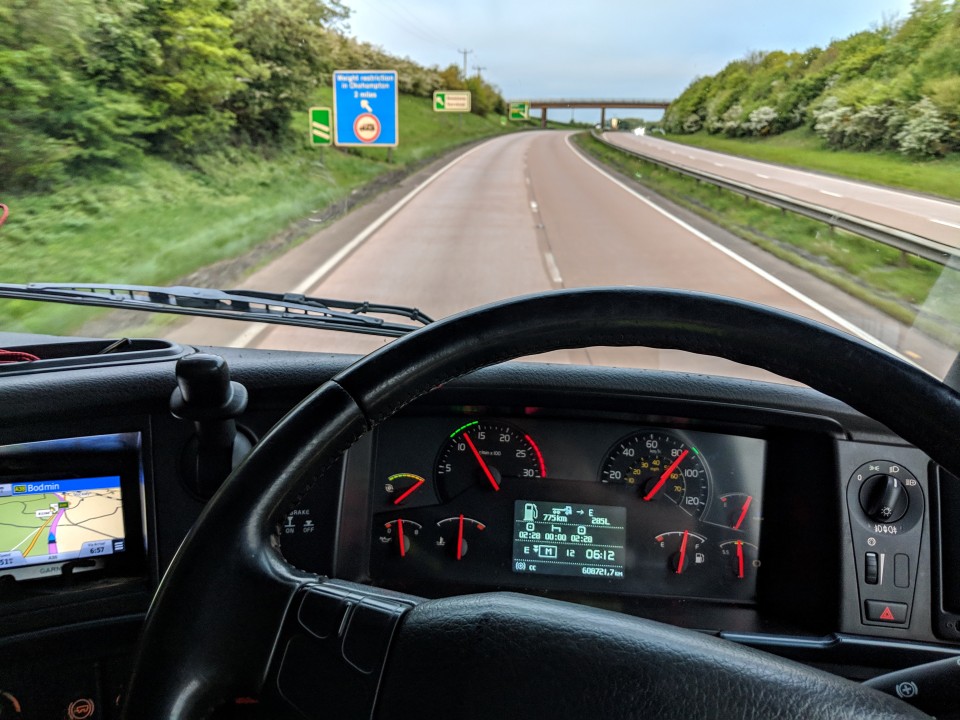
Susie Jones
Snadná pravidla pro tachografy
Vytvořeno: 01.08.2024
•
Aktualizováno: 08.08.2024
Svět pravidel pro tachografy může být nepřehledný i pro zkušeného řidiče nákladního vozidla. A co teprve pro nováčky v oboru. Naším cílem je objasnit některé z těchto nejasností.
Co je to tachograf a proč ho máme?
Podle slovníku je tachograf "zařízení, které se umisťuje do vozidel, jako jsou nákladní automobily a autobusy, aby zaznamenávalo informace, jako je rychlost jízdy, vzdálenost, kterou vozidlo ujede, a počet přestávek, které řidič udělá."
Účelem tachografu je zabránit únavě řidičů a zajistit, aby řidiči a zaměstnavatelé dodržovali předpisy. Charitativní organizace Brake zabývající se bezpečností silničního provozu uvedla, že "čtyři z deseti nehod způsobených únavou se týkají osoby řídící užitkové vozidlo". Pravidla pro tachografy proto hrají zásadní roli v úsilí o snížení tohoto počtu.
Kdy potřebujete tachograf?
Tachograf musíte mít, pokud celková hmotnost vašeho vozidla přesahuje tři a půl tuny. Je důležité si uvědomit, že to zahrnuje i tažení přívěsu. Z tohoto pravidla existuje několik výjimek:
Pokud jezdíte pouze mimo veřejné komunikace
Pokud vozidlo řídí ozbrojené síly, policie nebo hasiči.
Pokud jste komerční flotila a používáte vozidla s maximální hmotností sedm a půl tuny a vaše cesta je kratší než 100 km od vaší provozní základny.
Pokud převážíte zboží a vaše vozidlo je elektrické.
Pokud převážíte zařízení nebo stroje pro potřeby řidiče a řízení tohoto vozidla není vaší hlavní pracovní náplní.
Jaké jsou různé typy tachografů?
Existují tři různé typy tachografů:
Analogicky: V Evropě byly povinné od roku 1986. Analogové tachografy používají k záznamu údajů o řidiči listy voskového papíru. Řidiči údaje zadávají ručně a vkládají je do tachografu.
Digitální: Byly zavedeny v roce 2006. Používá je více než milion dopravních společností a přes šest milionů profesionálních řidičů. Digitální tachografy zaznamenávají údaje řidiče na interní paměťové zařízení a kartu řidiče.
Chytré: Evropská unie od června 2019 nařídila, aby společnosti používaly inteligentní tachografy. Ty automaticky zaznamenávají polohu vozidla na začátku a na konci každé jízdy. Každé tři hodiny také poskytují aktualizace
Co znamenají jednotlivé symboly tachografu?
Podívejte se na naše video, které vysvětluje jednotlivé symboly tachografu.
Porušení pravidel
V zájmu bezpečnosti řidiče nákladního vozidla a všech ostatních účastníků silničního provozu je nutné dodržovat pravidla pro přestávky. Rozebrali jsme jejich klíčové body.
Doba jízdy:
- Před přestávkou nesmí být delší než čtyři a půl hodiny.
Přestávky:
- Musí trvat alespoň 45 minut, pokud si řidič nevyužije přestávku na odpočinek.
Doba odpočinku:
- Během doby odpočinku nelze řídit ani vykonávat jinou práci.
Rozdělení přestávek:
Celou 45minutovou přestávku lze rozdělit na 15minutovou přestávku a následnou 30minutovou přestávku.
Rozdělení přestávek musí být rozděleno na čtyři a půl hodiny řízení.
Podle pravidel EU musí být v případě rozdělení přestávek druhá přestávka nejméně 30 minut.

Denní jízdní limit
Denní limit řízení se vztahuje na maximální dobu řízení za den. Maximální doba je devět hodin, ale lze ji zvýšit na deset. To však nelze provést více než dvakrát za stanovený týden. Denní dobu řízení lze definovat jako:
Celková kumulovaná doba řízení mezi koncem denní doby odpočinku a začátkem následující denní doby odpočinku.
Celková kumulovaná doba řízení mezi denní dobou odpočinku a týdenní dobou odpočinku. .
Týdenní a dvoutýdenní jízdní limit
Řidiči musí dbát na to, aby nepřekračovali maximální týdenní a dvoutýdenní limity řízení.
Maximální týdenní limit řízení je 56 hodin (platí pro pevný týden).
Pevný týden začíná v 00.00 hodin a končí ve 24.00 hodin následující neděli.
Dvoutýdenní limit pro řízení je 90 hodin.
Denní odpočinek
Kromě toho je třeba denně odpočívat.
Řidič musí nepřetržitě odpočívat 11 hodin. Tuto dobu lze zkrátit na devět
K tomuto snížení může dojít pouze třikrát mezi týdenními odpočinky.
Doba odpočinku musí být ukončena do 24 hodin po skončení poslední denní nebo týdenní doby odpočinku.
Denní odpočinek je možný ve vozidle, je však nutné mít vhodné prostory na spaní. Pokud tato zařízení chybí, musí si řidič najít ubytování. Podívejte se na naši stránku místa a zjistěte, které zastávky pro kamiony tuto službu nabízejí.
Týdenní odpočinek
Týdenní odpočinek musí být čerpán nejpozději na konci šesti po sobě jdoucích 24hodinových období od konce posledního týdenního odpočinku.
Řidiči jsou povinni odpočívat nejméně 45 hodin.
Mohou si dopřát zkrácený týdenní odpočinek v délce nejméně 24 hodin.
Zkrácený týdenní odpočinek musí být kompenzován v jednom bloku, a to nejméně devět hodin před koncem třetího týdne.
Přestože je možné využít zkrácený odpočinek, je třeba si uvědomit, že ve dvou po sobě jdoucích týdnech, kdy byl zkrácený odpočinek využit, musí jeden z nich trvat 45 hodin.

Vícečlenná posádka
Někteří řidiči mohou vzít na palubu dalšího řidiče. Mezi výhody patří vyšší produktivita, vyšší počet ujetých kilometrů a delší doba jízdy.
Oba řidiči musí denně odpočívat devět hodin
Tento denní odpočinek musí být čerpán v průběhu 30 hodin, nikoli 24 hodin.
První hodina jízdy ve více lidech nevyžaduje dalšího řidiče. Po jedné hodině se stává povinným.
Přejezdy trajektem nebo cestování vlakem
Jak je uvedeno výše, pravidelná denní doba odpočinku řidiče musí být 11 hodin nepřetržitě, avšak z tohoto pravidla existuje několik výjimek. Za předpokladu, že vozidlo doprovází řidič; denní doba odpočinku může být dvakrát přerušena, ale nesmí přesáhnout celkem jednu hodinu. Například při nástupu a výstupu na trajektu a ve vlaku.
Pokud je takto přerušena pravidelná denní doba odpočinku, musí být kumulovaná doba odpočinku alespoň 11 hodin nebo 12 hodin, pokud je rozdělena.
Co je pravidlo jedné minuty pro tachograf?
Pravidlo jedné minuty vstoupilo v platnost v říjnu 2011. Odkazuje na starší právní předpisy, které upřesňovaly, že minuta s alespoň pěti sekundami jízdy musí být zaznamenána jako doba řízení. EU však tuto legislativu změnila tak, že se do záznamu započítává jediná nejdelší souvislá činnost, která byla v rámci jedné minuty vykonána.
Co by se stalo, kdybych nedodržel pravidla tachografu?
Nedodržení pravidel pro tachografy může mít za následek pokutu a někdy i odnětí svobody. Obecně platí, že trest závisí na závažnosti porušení předpisů. Většina porušení pravidel tachografu je řešena pevně stanovenými pokutami. Řidiči mají na zvážení pevných pokut až 28 dní.
Ve Spojeném království existují dva druhy pokut a sankcí.
Pokuta čtvrté úrovně: je omezena částkou 2 500 GBP; tento limit platí pro každou pokutu za tachograf. V případech s více porušeními čtvrté úrovně však může být uložena maximální pokuta za každé porušení.
Pokuta páté úrovně: Její horní hranice je 5 000 liber, nicméně stejně jako u pokut čtvrté úrovně může být v případě více porušení předpisů uložena maximální pokuta.
Pravidla pro tachografy mohou být složitá na pochopení. Jejich nedodržování však může vést k bezpečnostním problémům a možným pokutám. Pochopením a dodržováním pravidel mohou vozové parky a řidiči provozovat svá vozidla bezpečně a legálně. Je důležité si uvědomit, že pravidla a předpisy pro tachografy se mohou v jednotlivých zemích lišit.



